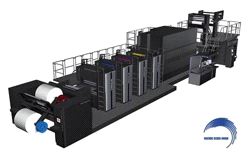Offset Printing
DIAMOND 16 MAX+S Wins Industrial Machinery Design Award

Monday 17. August 2009 - The DIAMOND 16MAX+S, a new commercial web offset press from Mitsubishi Heavy Industries, recently achieved a high honor: Award of The Japan Society of Industrial Machinery Manufacturers at the 39th Industrial Machinery Design Awards sponsored by Nikkan Kogyo Shimbun, Ltd. (Business & Technology Daily News).
In October of last year, Mitsubishi launched the DIAMOND 16MAX+S Series – a new lineup of commercial web offset presses designed to improve production efficiency and help ease the shortage of skilled press operators, a growing problem among Japanese web printing houses. The key feature of the DIAMOND 16MAX+S is its ultimate “one-button operation.” With this feature ideally targeting the growing number of small-lot multiple job variations, all printing operations from startup to print completion can be executed with a minimal amount of manual involvement.
The DIAMOND 16MAX+S is the first press ever to incorporate the following automated devices and mechanisms: MAX SimulChanger – a fully automatic high-speed plate changing system capable of changing plates at all colors in approximately one minute; a high-speed stream delivery 4/8-page module capable of direct product output from transfer belt to conveyor without delivery fans; MAX DIAMOND EYE – a color bar-less inline printing quality control system; and MAX Pre-Cut – a printing startup control function that eliminates cumbersome manual operation by automating cutoff alignment.
From a design standpoint, the exterior of the DIAMOND 16MAX+S brings comfort into the work environment by adopting smooth rounded forms without the overbearing equipment so common in conventional commercial web press plants. The design is an extension of the “soft geometric” concept first adopted in the DIAMOND V3000 line of Mitsubishi sheet-fed offset presses, which won Japan’s Good Design Gold Award in 2008.
In essence, Mitsubishi in designing the DIAMOND 16MAX+S has merged the unique sensitivity of Japanese designs with the warmth and simplicity of Scandinavian forms. Also included is the adoption of the multifunction LED beams along the side of the units that instantly display printing unit status through a series of multi-colored lights and flashing patterns. This feature facilitates safe operation even in remote locations.
Nikkan Kogyo Shimbun established the Industrial Machinery Design Award in 1970 to commemorate the 55th anniversary of its inaugural publication. With sponsorship from Japan’s Ministry of Economy, Trade and Industry and co-sponsorship from the Japan Chamber of Commerce and Industry and respective Industrial Federations, the award seeks to promote the advancement and development of industrial design in Japan. In the 39 years leading up to the 2009 award presentation, a host of pioneering designs expected to forge future directions in coming years have been recognized. The design candidates for the Industrial Machinery Design Award are mainly manufactured goods, and the main criteria are product quality and safety. Another essential element in selecting the winners is to clarify the modality of designs for performance improvement and industrial promotion in a new era. In addition to evaluation from overall perspectives such as economy and marketability, features such as ergonomic safety and suitability for welfare and the environment have recently taken on more prominence in the selection process.
In earlier years, awards have been conferred on three other Mitsubishi printing presses: the Design Award in 1983 for the 28-inch Mitsubishi 1E sheet-fed offset press, the Special Award in 2003 for the DIAMOND 16MAX Series, and the Award of The Japan Society of Industrial Machinery Manufacturers last year for the DIAMOND V3000 series. The DIAMOND 16MAX+S is Mitsubishi’s fourth award-winning printing press.
